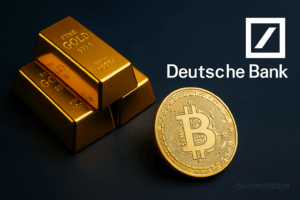Key Takeaways
- Deutsche Bank analysts believe Bitcoin (BTC) may begin appearing on central bank balance sheets by 2030, coexisting alongside gold rather than replacing it.
- Key drivers cited are declining volatility for Bitcoin, growing institutional adoption, clearer regulation, and improving liquidity.
- Despite optimism about Bitcoin’s possible reserve status, Deutsche Bank says the U.S. dollar is likely to remain the primary global reserve asset.
What the Report Says
Deutsche Bank’s latest research report (titled Bitcoin vs. Gold: The Future of Central Bank Reserves) argues that Bitcoin has matured in ways that make it a more credible asset for sovereign reserve portfolios. Some specific observations:
- In August 2025, Bitcoin’s 30-day volatility dropped to historic lows even as its price surged past US$123,500. This is noted as unusual because sharp price gains in past cycles have typically been accompanied by extreme volatility.
- Regulatory clarity is improving in many jurisdictions (e.g. U.S., EU, UK), which analysts believe is essential for Bitcoin’s adoption by central banks.
- Gold will still dominate official reserves for now, given its established role, liquidity, market depth, and legal frameworks. But Bitcoin is seen as a complementary hedge—particularly useful for inflation protection and geopolitical risk.
Why It Matters
- Portfolio diversification at the sovereign level: If major central banks start holding Bitcoin, the global asset mix of safe havens will shift. Gold has long been the go-to hedge; Bitcoin entering that realm could change reserve management strategies.
- Reduced volatility increases acceptability: One of Bitcoin’s biggest obstacles to reserve status has been its wild price swings. If volatility continues falling, central banks may feel more confident about its stability.
- Regulatory developments are crucial: Without clearer rules around custody, accounting, anti-money laundering (AML), and related infrastructure, adoption will stay cautious.
Challenges & Risks
Deutsche Bank also emphasizes there are still hurdles:
- Volatility remains high compared to traditional reserve assets when viewed over longer horizons. Short-term drops do not eliminate risk.
- Regulatory risk: Differences in how countries treat digital assets (tax, securities/commodities regulation, custody) remain significant. Any adverse regulation or bans could roll back gains.
- Liquidity & market depth: While institutional interest is rising, the infrastructure (custody, trading, settlement) and ability to move large amounts of BTC without excessive slippage are still in development.
What This Means for the Near Term
- Central banks in regions with inflationary pressure, or those seeking to diversify away from heavy dollar or bond-based reserve portfolios, may begin experimenting with small BTC allocations first.
- We may see further institutional moves (funds, ETFs, sovereign wealth funds) that mirror what central banks might do, helping build proof points for confidence.
- Expectations are that by 2030 this might be more than theoretical—it could be a defined trend if all pieces fall into place (regulation, custody, market stability).
Bottom Line
Deutsche Bank’s research signals that the idea of Bitcoin being part of official reserves is no longer fringe—it is being seriously considered. While gold remains firmly established, Bitcoin’s improving volatility profile, regulatory progress, and growing institutional adoption make it increasingly plausible that by 2030, central banks may hold both assets in their reserve portfolios. Whether those predictions will materialize depends on how the next several years play out for regulation, market liquidity, and macroeconomic pressures.
Also Check: OKX CEO Star Sees Promise in On-Chain Perps; Warns of Regulatory Risk
